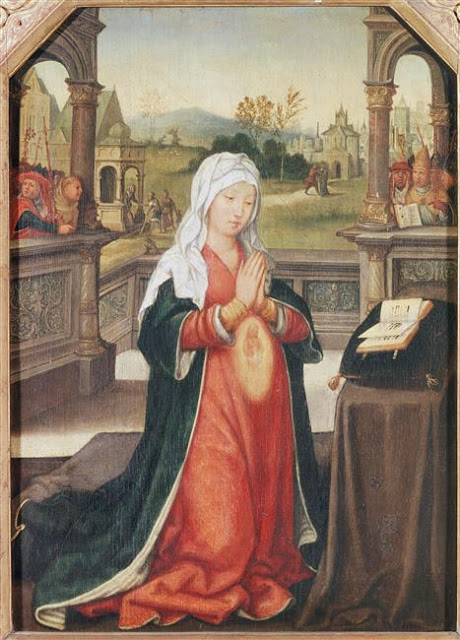Immaculate Conception, Mary’s Model of Holiness
Fr. Patrick Gaffney, SMM
“Hail Mary, Sinless in Your Conception!
Let My Tongue Proclaim It to the Heights of Sion.
I Want to Believe It For Your Greater Glory,
Despite the Devil and the World.”
St. Louis de Montfort: Cant. No. 90
Immaculate Conception, Mary’s Model of Holiness
Do you think that there is a lack of awe and reverence creeping into the Catholic church?
Many do. Yet there are also many others who welcome the “rediscovery” of the closeness of God, of Jesus as our brother who yearns to be treated as such. For these people, majestic awe, whether it be expressed in the liturgy or in personal prayer, artificially distances our Savior from us. Is the Blessed Sacrament surrounded with the devotion due to the real presence of the risen Lord? Many would instinctively cry out a loud NO.! Others would claim that familiarity with the Eucharistic Lord has not yet reached the degree required by an authentic renewal. And what about the respect for those in authority? Is the episcopacy – especially as exemplified in the bishop of Rome – the priesthood, the religious life, the married state, held in sufficient honor and fitting respect? Here again, one group shouts a YES.! (some say still too much awe!), another, a resounding NO.!
What Is Holiness?
All the above questions deal with how we are to treat the holy: God, Jesus, the Eucharist, the Church, ministry, marriage. Ultimately what is being asked is “what is holiness?”
One way to resolve the deadlock is to probe the meaning of the Immaculate Conception: God’s loving sharing of his holiness with Mary to a degree unfathomable. When we consider this gift of God to Mary, we gaze at the most powerful reflection of the holiness of Jesus – the Holy One of Israel – within the human family. An understanding of the Immaculate Conception gives us an insight into the meaning of holiness and, therefore, how we are to respond to it.
The Effects of the Immaculate Conception on Mary
There are two basic and seemingly contradictory effects of the Immaculate Conception upon . . . Mary. One is distance. The other is proximity. Distance: she is so far “beyond” the sinfulness of this rebellious world. Her holiness, begun in her Immaculate Conception, draws her deeply into the life of the trinity itself. In her presence we experience awe, reverence, distance. The dazzling beauty of her holiness accentuates the darkness of our sinful heart. Truly, “the Almighty has done great things for her.”
Proximity: the Immaculate Conception also makes her so close to us. For holiness is a sharing in infinite love, care, concern. Mary has never been dehumanized by sin. She is, then, so loving, so filled with concern for us, so approachable, so sensitive to our needs. It is precisely her holiness which makes her motherhood of the church so vibrant, so real, so intimate.
Holiness, then, entails proximity in distance, or if you like, distance in proximity. The more we consider the inexpressible majesty of the Immaculate Conception, the more we experience the powerful closeness of Mary to [all of us].
Saint Louis de Montfort, while extolling Mary’s grandeurs in baroque terms, calls her “the little girl” of the human family. While insisting that she is “all-powerful” as intercessor with her Son, he immediately declares that she is always the “servant.” His writings and life bring out clearly both the awesomeness of Mary so graced by God and at the same time, her maternal intimacy with each one of us.
Both Awe and Familiarity Must Characterize Our Response to Holiness
Holiness, then, is not either closeness or proximity. Holiness calls for not either awe or familiarity. Rather, BOTH concepts must be included in holiness and BOTH attitudes must characterize our response to holiness.
Those, therefore, who want to throw out awe and majesty from the liturgy are wrong. So too are those who reject any expression of closeness, familiarity. What the Immaculate Conception teaches us is that we must search for a balance. We need both reverence and intimacy. Those who are “holy” – and we all are because of our baptism into the Holy One, Jesus – must call forth from others both distance and closeness, both awe and intimacy. Not one or the other. Both.
Those who hold special places within the consecrated people of God, especially priests and religious, must reflect the holy in a special manner. Through the way they live, speak, dress, they must evoke reverence while at the same time, precisely because they are holy, calling forth closeness, familiarity.
It is all too easy to fall off the tightrope and over stress either magnificence or simplicity, distance or proximity, awe or intimacy. There is a noticeable tendency in many quarters of the church to restore especially one aspect of our response to the holy: awesomeness, distance, majestic reverence. All well and good – provided – that intimacy is thereby intensified. Otherwise, as Mary Immaculate illustrates, we have lost sight of the true meaning of holiness.

St. Anne Conceiving the Virgin Mary: Flemish Painter: Jean Bellegambe 1470-1535
The painting resides in the Douai Museum in France.
One way to resolve the deadlock is to probe the meaning of the Immaculate Conception: God’s loving sharing of his holiness with Mary to a degree unfathomable. When we consider this gift of God to Mary, we gaze at the most powerful reflection of the holiness of Jesus – the Holy One of Israel – within the human family. An understanding of the Immaculate Conception gives us an insight into the meaning of holiness and, therefore, how we are to respond to it.
Return to The Queen Articles
This article, Immaculate Conception, Mary’s Model of Holiness, originally was published as an Editorial. The original title was: Mary Immaculate, Model of Holiness.


